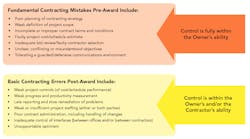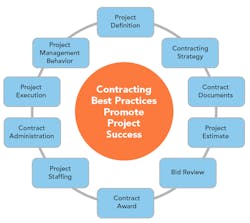Project contracting covers the spectrum of pre-award and post-award activities — from developing and awarding contracts through their administration. An owner’s good contracting practices throughout these stages can avoid costly time-consuming mistakes and adverse impacts, and help ensure project success. Such practices facilitate good project management for both the owner and contractor, regardless of project scope.
Contracting is highly successful for some projects but much less so for others. The latter usually suffer from mistakes and adverse impacts that can result in poorer-than-expected performance, disputes or claims.
Mistakes made in contracting are not attributable to a particular type of project or contract type or to geographic location. They occur both before and after contract award (see Figure 1), and affect project outcome. It’s important to understand that contracting mistakes are project management mistakes.
So, here, we’ll look at common mistakes and how to avoid them. While this article is written from an owner’s perspective, its concepts and recommendations also should prove useful to contractors.COMMON MISTAKES
One or more reasons may contribute to an organization’s contracting method/process “missing the target.” Common mistakes include:
- Inappropriate strategy, e.g., a lump-sum basis applied to a poorly defined new or revamp project, resulting in a proliferation of changes.
- Misfocused bid review balance, e.g., one too centered on a contractor’s commercial offerings with not enough attention devoted to the contractor’s capabilities/execution plans/people and necessary upgrades of these.
- Faulty contractual terms, i.e., incomplete or ambiguous definition of scope, obligations, deliverables or completion requirements, or imposing onerous/inequitable risk conditions.
- Flawed project targets, e.g., poor quality/unrealistic cost and schedule estimates.
- Inadequate team composition due to underestimating the number or qualifications of resources needed for the project.
- Wrong management procedures, i.e., weak tools/practices used to steward project performance.
Contracting mistakes directly correlate with adverse business impacts. These errors often can increase project costs as a result of a higher-than-normal level of change orders. Adverse business impacts also include longer project schedules, which occur just as frequently as cost increases. Longer schedules, which can extend for several additional months, can be change-order driven as well as caused by lower productivity. Other negative business impacts of contracting errors include quality, startup and operability problems, often due to higher-than-normal defects/deficiencies during project execution as well as disputes and claims, along with the damaged business relationships they generate.
Many contracting mistakes stem from issues that received insufficient attention, such as not starting the contracting process early and, thereby, foreclosing options that may be optimum for the project. Other issues that sometimes get inadequate consideration are examination of the balance of contract risks (execution, commercial and legal) between the owner and contractor as well as a good definition of project objectives, which can be unclear and not prioritized. Project schedules that don’t have at least a 50% probability of achievement and cost estimates with inappropriate contingency levels also can set a project up for failure at the outset of contract award.
TEN BEST PRACTICES
By adhering to these, an owner can avoid contracting pitfalls and promote project success. Figure 2 shows these key practices. Let’s look at what they involve:
1. Project Definition. Regardless of project or contract type, ensure the project is well defined. Confirm its objectives, scope, site conditions, schedule and execution strategy are clear, complete and suitable for obtaining good bids.2. Contracting Strategy. At the earliest possible point, analyze all viable compensation options and select the optimum approach for the project. Outline project risks and mitigation measures (both pre- and post-award). “Select the right horse for the course.”
3. Contract Documents. Use sound, proven and comprehensive contract templates and then tailor them for the project; confirm the contract satisfies the “4 Cs” — clear, complete, concise and consistent.
4. Project Estimate. Verify the cost/schedule estimate and its development basis are sound and consider factors such as site specifics, market conditions, execution strategy, labor availability/productivity, good benchmarks, an appropriate contingency, etc. Use peer reviews to test the estimate’s quality and its confidence level.
5. Bid Review. Carefully plan and document the bid review (e.g., methodology, selection criteria, review team, schedule) before receipt of proposals. Never allow a bidder to “buy” the contract with unusually low commercial terms. Ensure the bid review focuses on the contractor’s execution experience with similar projects and that plans are sound and tailored for the specific project, and evaluate the quality of key people to be assigned to the work. Remember during negotiations: “Your business relationship starts during bid review.”
6. Contract Award. Select a reputable/capable contractor. Confirm both parties fully understand the contract requirements as well as any special risks or unusual commitments. Use team workshops after the award to promote joint understanding and foster alignment.
7. Project Staffing. Before award, make sure both contractor and owner resources are qualified, sufficient in number, and deployed on time to manage the project, including its interfaces. Clarify roles/responsibilities within the team and, when more than one office or entity will provide services, verify roles/interfaces/plans are well understood.
8. Contract Administration. Ensure timely/fair administration to maintain the sanctity of the contract terms. Use appropriate/effective change-management forms/procedures to steward potential and agreed changes. Keep communications open and frequent (a “no surprises” approach).
9. Project Execution. Require weekly assessment and reporting of key performance indicators such as cost (expended, incurred, forecast), progress versus schedule, productivity, safety and other critical issues. Thoroughly capture the status of all vendors’ and subcontractors’ work.
10. Project Management Behavior. Strive to function as a single team working together toward a common goal:
- promote open communications at all levels and foster a “we” versus “me” behavior;
- recognize accomplishments;
- promptly process information requests and scope variations;
- don’t allow disputes to fester — analyze and escalate disagreements until resolved;
- regularly monitor performance, closely steward against plan and ensure corrective actions are effective; and
- set an example of honesty, integrity and consistency.
EMULATE INDUSTRY PACESETTERS
A pacesetter generally is defined as an individual/company that is more successful than its competitors by developing new products, methods, standards, etc., before anyone else. In our industry, a pacesetter is an organization whose capital projects are consistently completed on-time and within budget to established quality and safety standards and without claims.
Along with the ten best practices outlined above, industry pacesetters use other techniques to ensure effective contracting practices and successful project completion:
• Documented Contracting Procedures. These cover the full contracting process with checklists for key contracting steps.
• Proven Well-Constructed Contract Templates. These are designed for various compensation and types of project contracts, and come with accompanying guidance on how to tailor the templates for projects.
• Good-Quality Resources Dedicated To Project-Contracting Activities. This often is a centralized group of strong performers — very knowledgeable of contracts, the contracting process and the market. These people are project experienced, well-trained and selected for their skills/capabilities (and do not handle routine purchasing activities).
• High-Quality Training Programs. These cover all major aspects of contracting.
• Superior/Up-To-Date Database. This provides accurate information on past strategies, bid reviews, contracts, project outcomes, contractor’s performance, market trends and lessons learned.
• Efficient And Effective Communications/Cooperation. Open and supportive dialogue occurs between members of each project team and the contracting personnel.
• Single Points-Of-Contact For Functional Support. This involves selecting a suitable person in law, tax, finance, etc., i.e., someone well-versed in project contracts.
CONQUER CONTRACTING CHALLENGES
Contracting covers a wide spectrum of activities from early project planning through project execution and close-out — activities that are integral to good project management. You can promote project success by consistently applying contracting best practices and the drivers used by industry pacesetters. Good contracting practices minimize adverse business impacts and facilitate contract administration.




